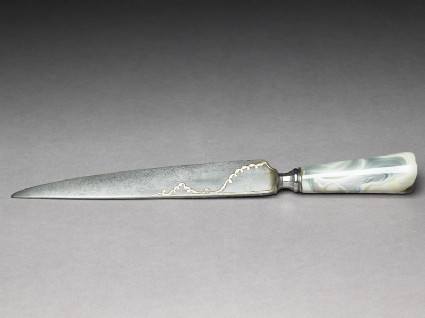Browse: 10610 objects
- Reference URL
Actions
Kard, or dagger, with an agate hilt
-
Description
In 19th-century Iran, a few types of dagger – mentioned in some detail by the accounts of European travellers of the time – seem to have been worn most commonly: the khanjar, a curved, double-edged blade mounted on a sword-hilt, the kard, a knife with a straight, single-edged blade, and the qama, a long-bladed dagger introduced in Iran from the Caucasus at this time.
This example of a kard has a watered steel blade, inlaid with gold, and a rare agate handle. It was likely made in Isfahan, a major centre of production for kards at this time.
The goldwork is signed by the craftsman Muhammad Hadi and dated to the year 1230 of the Islamic calendar, corresponding to 1814-1815 AD. Hadi is known from at least two other daggers, one in the Moser collection at the Historical Museum, Bern, and the other in the Victoria and Albert Museum.
-
Details
- Associated place
- Date
-
1814 - 1815 (AH 1230)
Qajar Period (1779 - 1925)
- Artist/maker
-
Muhammad Hadi (active early 19th century)
- Material and technique
- watered steel blade, inlaid with gold; agate hilt
- Dimensions
-
3.3 x 32.8 x 3.3 cm max. (height x width x depth)
blade 3 x 23 x 0.8 cm max. (height x width x depth)
- Material index
-
processed material › metal › alloy › steel,processed material › metal › gold,
- Technique index
- Object type index
-
arms/armour › weapon › dagger
- No. of items
- 1
- Credit line
- Purchased with the assistance of the Friends of the Ashmolean Museum, 1998.
- Accession no.
- EA1998.36
Location
Objects are sometimes moved to a different location. Our object location data is usually updated on a monthly basis. Contact the Jameel Study Centre if you are planning to visit the museum to see a particular object on display, or would like to arrange an appointment to see an object in our reserve collections.
Galleries
© 2013 University of Oxford - Ashmolean Museum





